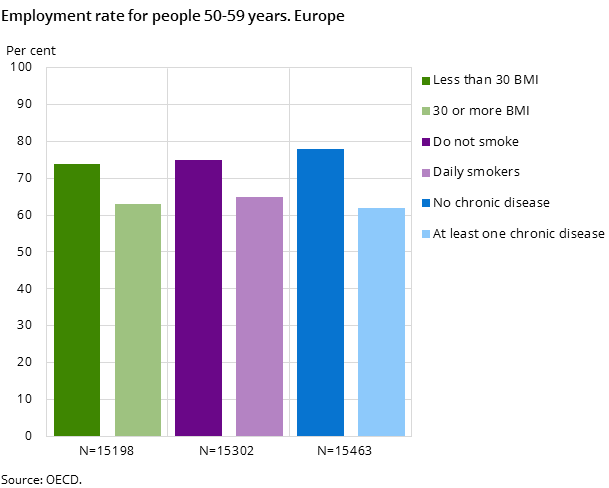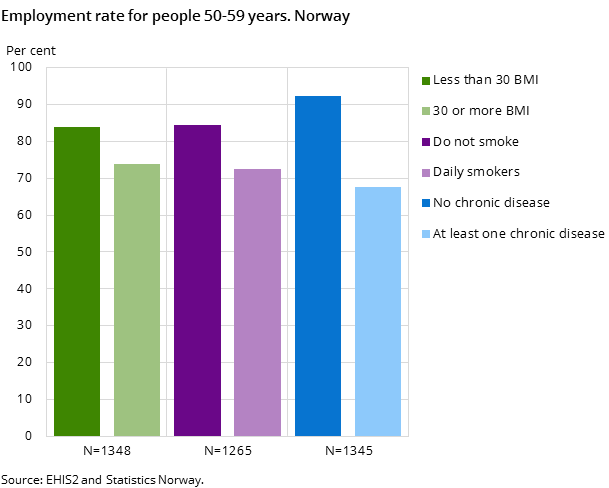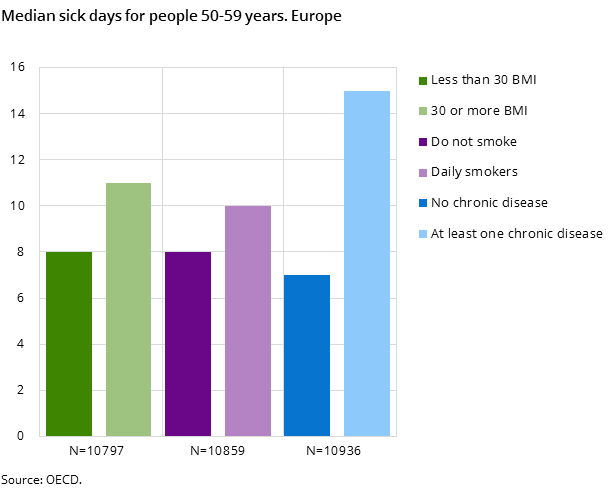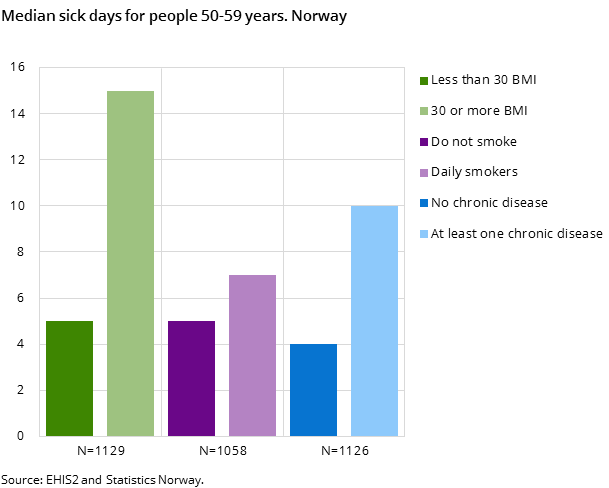Health at a Glance 2016 - Health Conditions in Europe and Norway
Three times as many sick days among obese Norwegians
Published:
Obese Norwegians aged 50-59 report more sick days, and are less employed than their peers.
- Series archive
- Health at a Glance
In Health at a Glance, 2016 (HAAG) OECD assesses labour market outcomes of selected modifiable risks to health such as smoking and obesity, and related chronic diseases for people aged 50-59. Norway is not included in the data. Read more about the data here.
People with behavioural risks to health are less employed
Figure 1 shows how modifiable risks to health such as obesity and smoking impact the employment rate. On average, the proportion of this group in employment is 10 per cent lower compared to their peers who do not share their behavioural risks. This is particularly obvious in Spain, where less than half of obese people are employed. Those who suffer from chronic diseases also have a lower employment rate than their peers, and there is clearly a barrier to the labour market when suffering from at least one chronic disease. 8 in 10 Danes with at least one chronic disease are in employment, not only beating the European average of 6 in 10, but also the average for healthy Europeans.
Norwegians with chronic diseases have lowest employment rate
The figures for Norway closely resemble the European average. Risk factors to health such as smoking, obesity and related chronic diseases may be detrimental to the employment rate. The employment/non-employment disparity between those suffering from at least one chronic disease is greater in Norway than the European average.
Fewer obese Norwegians aged 50-59 are in employment than those with a BMI below 30. 7 out of 10 are employed, while the corresponding figure for their non-obese peers is 8 in 10. Obesity or the lack thereof appears to be quite an important factor in relation to employment. Results concur with the European average, where lower proportions of employment are consistently observed among obese people. Norway has better employment rates among both obese and non-obese than Europe.
There are fewer Norwegian daily smokers aged 50-59 in employment compared to their non-smoking peers. 73 out of 100 daily smokers are in employment, while the corresponding figure for non-smokers is 84 out of 100. There is a sizeable disparity in the employment rate of 11 per cent. The employment disparity is similar to the trend observed in Europe.
The largest employment/non-employment disparity is found for those suffering from at least one chronic disease. 9 in 10 of those who are not affected by a chronic disease are employed, while the figure for those with at least one chronic disease is 7 out of 10. For this latter group, the barriers to employment are greater than for their healthy peers.
Europeans with chronic diseases have more sick days
Sick days can be used as a measurement of productivity in the workplace. Figure 3 indicates that for Europe, chronic diseases increase the amount of sick days more than the respective behavioural risks discussed. Europeans suffering from at least one chronic disease take eight extra sick days, which is twice as many as those without chronic diseases.
Figure 4 shows a similar situation in Norway, albeit with clearer disparities. Obese Norwegians take the most sick days compared to daily smokers and people with one or more chronic diseases. The number of sick days reported for the obese is three times higher than for those who with a BMI of less than 30. The pattern for chronic diseases and daily smoking is the same as the European trend, but Norway has fewer sick days in general.
Fewer sick days in Norway
Obese Norwegians aged 50-59 have had 15 sick days during the last 12 months; 10 days more than their non-obese colleagues. Along with Denmark and Switzerland, Norway has the lowest number of sick days in general among the non-obese.
Daily smokers have slightly more sick days than non-smokers. Employees aged 50-59 who smoke on a daily basis have seven sick days; two more than their non-smoking colleagues. Norway is low in the scale in a European context, with Norwegian daily smokers taking the fewest sick days, along with Denmark, Sweden, and Switzerland.
Norwegians suffering from at least one chronic disease work fewer days than their healthy peers, with 10 and 4 sick days respectively. In a European perspective, Norwegians with at least one chronic disease have just as many sick days as others, while the healthy have fewer.
Contact
-
Joachim Wettergreen
-
Statistics Norway's Information Centre




